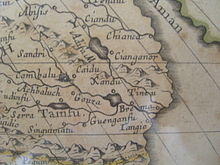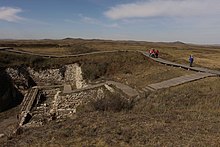Shangdu (Yuan Dynasty)
| Xanadu ruins | |
|---|---|
|
UNESCO world heritage |
|
| National territory: | China |
| Type: | Culture |
| Criteria : | (ii) (iii) (iv) (vi) |
| Surface: | 25,131 ha ha |
| Buffer zone: | 150,721 ha |
| Reference No .: | 1389 |
| UNESCO region : | Asia |
| History of enrollment | |
| Enrollment: | 2012 (session 36) |
Coordinates: 42 ° 21 ′ 35 " N , 116 ° 10 ′ 45" E

Shangdu ( Chinese : 上 都, Shàngdū or 元 上 都Yuán Shàngdū ), also known as Xanadu , was the summer residence of Kublai Khan , the emperor of China , during the Mongolian Yuan dynasty . It was created in 1256. Early Western knowledge of Shangdu dates back to an alleged visit by Marco Polo in 1275. In 1369, Shangdu was captured by Ming troops and then completely destroyed. The last Mongolian emperor of China, Togan Temur , was able to escape the city before. The ruins of the former city were partially uncovered, archaeologically examined and made accessible to the public as an open-air museum . The ruins have been recognized as a UNESCO World Heritage Site.
location
The ruins Shangdus now lies about 29 km north-east of Duolun on the shore of Luan River , which here, where he a bow by the Inner Mongolia pulls Shandian He (闪电河) is called. It is also located in the administrative area of the Wuyi State Livestock Farm on the northeast border of the administrative area of the Shangdu Municipality in the Zhenglan banner of the Aimag Xilin Gol of Inner Mongolia, People's Republic of China .
World Heritage Site
In 2012 the ruins of Shangdu were included in the UNESCO list of World Heritage Sites under the title Site of Xanadu , in German "Ruins of Xanadu" . In the application, this is justified with four criteria: The ruins show an urban planning which illustrates the integration of the culture of the Mongols and the Han; The surrounding landscape and the former gardens show the symbiosis of nomadic culture and agriculture and they remind of the role of the city as the venue of a great debate between Buddhists and Taoists in the 13th century, which resulted in the spread of Tibetan Buddhism in Northeast Asia.
Shangdu's reception in the west as "Xanadu"
In the west, the city is also known as Xanadu, which goes back to the 1816 poem Kubla Khan by the romantic English poet Samuel Taylor Coleridge . Its first stanza is:
- In Xanadu, Kubla Khan did
- A stately pleasure-dome decree:
- Where Alph, the sacred river, ran
- Through caverns measureless to man
- Down to a sunless sea.
In a German adaptation by Wolfgang Breitwieser :
- In Xanadu, Kubla Khan created
- A pleasure palace, proud and heavy with a dome:
- Where Alph, the river of salvation, ran
- Through caves that no one can measure
- In the sunless sea.
(Pop) cultural reception

- architecture
- The arms manufacturer and chemist Irénée du Pont called his villa in Varadero ( Cuba ) built in the 1920s Xanadu Mansion . Today the house is a hotel and a luxury restaurant.
- Xanadu Homes : A series of three experimental residential buildings in the United States in the early 1980s (dismantled today). The objects were intended to demonstrate state-of-the-art building materials and home automation techniques.
- A shopping and entertainment center near Madrid that opened in 2003 is called Xanadú .
- Movie
- As a symbol of prosperity, the name found its way into Orson Welles ' film Citizen Kane (1941), the protagonist of which named his castle, filled with antiques, Xanadu . The real model for this was the Hearst Castle of the media entrepreneur William Randolph Hearst in California.
- In the feature film Nordsee ist Mordsee (1976, director and screenplay: Hark Bohm ), the raft built by the boys is called Xanadu
- The poem is also quoted in the music film Xanadu (1980), in which the eponymous dance hall is named.
- In the psychological thriller Sanctum 3D (2011), the aforementioned poem is recited appropriately several times.
- Fiction
- The essay El sueño de Coleridge ( Coleridge's Dream ) by Jorge Luis Borges (1951) refers to the Xanadu poem.
- Cordwainer Smith refers to Coleridge's work in the science fiction short story Down To A Sunless Sea (1975) as part of the “instrumentality of mankind”.
- Douglas Adams quotes Coleridge's poem in chapter six of The Electric Monk (1987).
- In Tad Williams ' book series Otherland (1996–2001), Xanadu exists as one of the virtual worlds that were created as a retreat for power-obsessed people in search of immortality.
- The Austrian author Wilfried Steiner takes up the subject with his 2003 novel Der Weg nach Xanadu .
- music
- Dave Dee, Dozy, Beaky, Mick & Tich had a hit in 1968 with the song The Legend of Xanadu .
- The Canadian rock group Rush brought out their album A Farewell to Kings in 1977 . a. an eleven minute piece of Xanadu based on Coleridge's poem.
- In 1980 Electric Light Orchestra released Xanadu (a soundtrack, a "half" studio album, so to speak) with Olivia Newton-John . Ireen Sheer sang the German version of this song .
- In 1984 the term inspired the pop group Frankie Goes to Hollywood when naming their debut album Welcome to the Pleasuredome , which went straight to number 1 on the UK album charts thanks to a million pre-orders. The single of the same name, released in early 1985, also refers to Xanadu and Kublai Khan.
- Comic
- Madame Xanadu is a character in DC Comics . She made her first appearance in Doorway to Nightmare # 1 (1978).
- Xanadu also appears in Onkel-Dagobert volume No. 8 by Don Rosa (1991), in the story Reunion with Tralla La .
- Computer science
- Xanadu is the namesake of Ted Nelson’s hypertext project in 1960 with the attempt to create a universal library with countless networked documents.
- Video games
- The video game Xanadu , released in 1985, is the second part of the action role-playing game series Dragon Slayer .
- The 1987 action-adventure game Faxanadu is an offshoot of the aforementioned for Nintendo Famicom or NES .
- In the computer game GTA 2 (1999), the headquarters of the Zaibatsu Corporation in the Downtown District is also called Xanadu.
- In the computer game Ni no Kuni: The Curse of the White Queen (2011), a fallen kingdom is called Xanadu.
- In the computer game Tokyo Xanadu (2015), the protagonist's club is called the Xanadu Research Club.
- astronomy
- A region on Saturn's moon Titan is called Xanadu.
Individual evidence
- ↑ a b UNESCO World Heritage Center: Site of Xanadu. Retrieved August 19, 2017 .
- ↑ Full text at: https://www.poetryfoundation.org/poems/43991/kubla-khan
- ↑ Horst Höhne (ed.): A thing of beauty is happiness forever. English and Scottish Romantic poems. Reclam, Leipzig 1980, p. 276.
- ↑ Interview with Hark Bohm, FILM-Korrespondenz , March 24, 1976; ( online )




